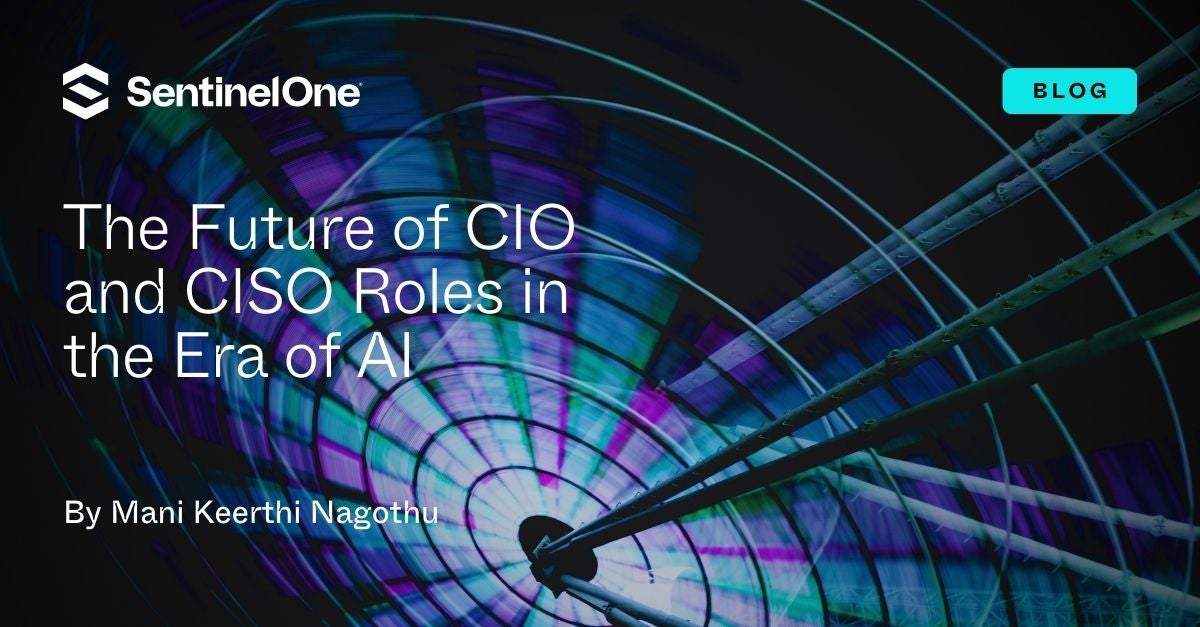As more organizations adopt artificial intelligence (AI) in their businesses, the roles of Chief Information Officer (CIO) and Chief Information Security Officer (CISO), along with their collaborative responsibilities, are set to evolve.
These have traditionally been technical, but are now becoming increasingly strategic as AI transforms business operations. CIOs are moving from managing IT needs to overseeing the strategic adoption of new technologies, while CISOs are evolving from being siloed security experts to visionaries in strategic cybersecurity and business growth.
This blog discusses the current trajectory for CIOs and CISOs, their changing priorities, and possible paths forward for their roles in the future.

CIO Trajectory | Upskilling and Adapting
The role of the CIO is shifting dramatically as AI becomes a critical component of business strategy. Traditionally focused on managing IT infrastructure, CIOs must now lead the integration of AI technologies, necessitating new skills and strategic thinking.
Embracing the AI Revolution
With Generative AI (GenAI) coming into widespread use, businesses are eager to integrate AI into their processes. This shift will likely lead to changes in leadership roles, including the emergence of new roles such as the Chief AI Officer (CAIO). The CAIO is responsible for heading AI initiatives and optimizing data use to support business needs. As the CAIO role is still developing and not defined for many organizations, CIOs instead are taking the lead and experimenting with AI use cases and assessing their return on investment.
Preparing for the Future
The emergence of the CAIO role is supported by the fact that the combination of AI and data will be pivotal in determining business strategy for organizations. As organizations become more AI-powered, managing in-house infrastructure may decrease, shifting towards managing third-party services where businesses own the data but not the underlying infrastructure. This shift will vary by industry and organizational priorities.
To prepare for these changes, CIOs can upskill in AI, understanding the technology stack to evaluate and adapt to their organization’s needs. While they do not need to develop AI systems themselves, they must be well-versed in the workings of AI systems.
CISO Trajectory | Accountability with Authority
While CIOs focus on enhancing customer experiences, digital transformation, and operational efficiency, CISOs prioritize data security and integrity. This balance becomes even more challenging with the advent of new technologies like AI, where integrating security from the outset is essential. Successfully managing these differing objectives requires a collaborative approach and a security-first culture that aligns with overall business goals.
Balancing Priorities
Traditionally, CIOs focus on enabling better customer experiences, digital transformation, cost savings, IT efficiency, and supporting seamless operations. CIOs are also tasked with providing uninterrupted service to the organization’s employees to support continuous operations and sales. For CISOs, it is more about how securely data is stored, accessed, and transmitted.
For example, CISOs and CIOs often find themselves to have an agreed conclusion on the path forward when it comes to the patch management process within an organization. According to Automox’s 2022 Unpatched Vulnerability Report, 60% of breaches are tied to unpatched vulnerabilities. One of the reasons organizations do not patch is CIO’s objective is to avoid business interruption while the CISO’s objective is to secure the organization.
The above example highlights just one situation where there is a recurring struggle for CISO to manage the security side of the infrastructure that is generally owned by a CIO in the organization. It then falls on the security team to develop and design ways to secure these legacy systems, sometimes needing additional steps or controls because of the complexity and no support available to them.
Securing Emerging Technologies
As AI evolves, so do the security challenges associated with it. CISOs are tasked with ensuring that security is integrated into every technology acquisition and deployment, moving away from treating security as an afterthought. However, from a business perspective, it is about bringing efficiency to the processes and gaining productivity. This is where CISOs are presented with this unique challenge of bringing a balance to the organizational priorities.
CISOs are engaging in discussions where they need to proactively address potential vulnerabilities, especially as discussions around AI ownership and security remain fluid within the industry. This starts with the organizational culture, where security is treated as first and center of everything.
Placing Security at the Center
Adapting to the changing threat landscape requires expanding the traditional CIA triad, moving towards a more objective-oriented security approach. As AI-based tools advance, organizations need to shift and address new risks and threats. Integrating security objectives into every aspect of technology deployment harmonizes CIO and CISO priorities, ensuring a comprehensive strategy that includes robust organizational culture, aligned KPIs and KRIs, and dedicated resources. Organizations that embrace this holistic approach can stay ahead of cyber threats and secure innovative technologies more effectively.
Expanding the CIA Triad
There have been numerous discussions in the past about how the CIA triad (Confidentiality, Integrity, Availability) may not work for all technologies and associated security risks. As it stands, many organizations are not able to keep up with the speed at which AI and AI-based tools are developing, thus falling behind on how best to deploy and secure this technology safely. The risk landscape for AI is only growing, and threat actors are already leveraging AI for nefarious purposes.
If we look at an attacker’s objectives for predictive AI systems, referencing NIST’s AI Adversarial Machine Learning publication, the attacker’s objectives are availability breakdown, integrity violation, and privacy compromise. In the case of GenAI systems, an additional objective is abuse violations. As the attacker’s objectives evolve with technology, it is critical to address these objectives within the CIA framework, adapting it as needed for specific situations or use cases.
Objective-Oriented Security
Placing security objectives at the center of a circular model can harmonize the priorities of CIOs and CISOs, ensuring that security is integral to all technology deployments. This approach emphasizes security in every aspect of operations, addressing emerging threats and implementing measures for emerging technologies such as IT, IoT, OT, and AI in a more optimized way.
Key elements that contribute to this strategy include:
- Organizational Culture – Ensuring that security is prioritized in every action and decision within the organization.
- Key Performance Indicators (KPIs) and Key Risk Indicators (KRIs) – Aligning these indicators with business goals to measure and manage security effectively.
- Resources – Allocating the necessary resources to implement and continuously improve this security strategy.
The Way Forward for the Role of the CISO
As the businesses prioritize digital transformation and adoption of new technologies, the role of the CISO has become pivotal in defending against evolving threats. An empowered CISO ensures their organizations remain strategic with their security approach, meet evolving cyber regulations, and minimize the impact of cyber attacks on their business.
Proactive Decision-Maker with Authority
The role of the CISO is shifting from a business enabler to a proactive decision-maker, essential for scaling and securing organizations against evolving threats. CISOs must be empowered to make decisions about the technology environment, balancing risk management with business needs. One possibility is to place CISOs as decision-makers for all technology-related security matters while CIOs manage risks based on set security objectives aligned with business needs. This approach emphasizes the importance of cybersecurity as a strategic risk. While this approach may not work for every organization, it is a better way to approach security needs for evolving technologies.
Conclusion
As emerging technologies such as AI accelerate business transformation, the roles of CIOs and CISOs must adapt. Integrating security into every aspect of technology deployment and management is crucial. While updating the foundational technology environment will take time, the evolving technology landscape will invite more discussions on necessary changes.
While this is one way to approach evolution, it is important to acknowledge that organizations of different sizes may approach this in their own way. Other roles, such as the Chief Technology Officer (CTO) and the Chief Data Officer (CDO), may also start to transform alongside CISOs and CIOs as businesses find ways to integrate AI into their processes. Secure use of AI applications, AI, and data have the potential to drive major decisions for businesses as we move forward into the future.


